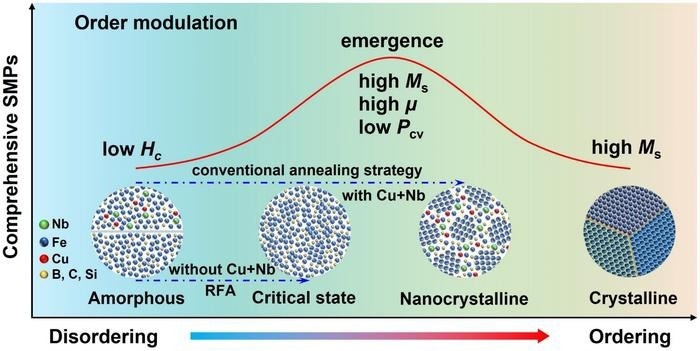Reviewed by Lexie CornerMar 6 2024
Energy technologies depend on soft magnetic materials but are difficult to work with at high frequencies. A multidisciplinary team of researchers suggests a cutting-edge technique to enhance their characteristics for future applications in electronics.
 Order modulation strategy to optimize the soft magnetic properties of Fe-based alloys. Image Credit: Professor Haibo Ke from Songshan Lake Materials Laboratory
Order modulation strategy to optimize the soft magnetic properties of Fe-based alloys. Image Credit: Professor Haibo Ke from Songshan Lake Materials Laboratory
Envision a world powered by minuscule magnets that discreetly turn energy on and off in cars, phones, and even power grids. These unsung heroes are called soft magnetic materials.
However, as contemporary devices get faster and more efficient, conventional materials find it difficult to withstand high frequencies. Enter amorphous soft magnetic composites (ASMCs). They resemble metallic powders with tiny air gaps and interfaces covered in a unique coating.
As a result, they exhibit properties like flexible designs and low power loss, which makes them extremely effective at handling high frequencies. However, there is a catch: compared to conventional materials, their magnetizations are lower. Thus, scientists aim to discover the ideal ratio of magnetic strength to softness for the sake of devices in the future.
Although ASMCs are fast, their magnetic strength is not very strong. It is comparable to driving a fast but insufficiently powerful race car with a weak engine.
The solution? The “critical state” approach is a neat trick that a group of Chinese scientists from Songshan Lake Materials Laboratory uses. Like a potter molding clay, picture these materials subjected to a revolving magnetic field. This facilitates their slight crystallization, forming minuscule, incredibly effective magnetic regions inside them.
The result? An effective and powerful magnetic material. Features of this “critical-state” ASMC include:
- Strong magnetic field: Similar to a powerful engine
- Low energy loss: Similar to a car that uses less fuel
- Operates at elevated frequencies: Stays current with technology
This is only the start of what has been found. Researchers are investigating entirely new materials as well as utilizing various coatings and shaping methods to further enhance ASMCs.
Such a strategy for constructing a critical-state amorphous alloy can allow us to develop novel ASMCs and promote the development of modern electronics, especially in high-frequency fields. In the future, on the one hand, the synergism of high permeability, low core loss, high magnetization, and high application frequency can be achieved through process optimization, such as using novel coating layers (magnetic and insulated) and new techniques in compaction.
Haibo Ke, Professor, Songshan Lake Materials Laboratory
Haibo Ke added, “On the other hand, developing new powder compositions and modifying the intrinsic microstructure such as the order modulation strategy and nanocomposites engineering allow us to break the trade-off between “magnetic strength” (saturation magnetization) and “magnetic plasticity” (coercivity/core loss).”
“It is certainly possible to develop high-performance ASMCs and entirely soft magnetic materials, and the scientific community has already launched some activities that will promote the transform of the power electronics fields, especially the third-generation semiconductor related devices,” concluded Haibo Ke.
These developments will open the door for more energy-efficient electronics in phones and power grids, which will ultimately fuel a future powered by high frequencies.
Journal Reference:
Shao, L., et al. (2024) Critical state-induced emergence of superior magnetic performances in an iron-based amorphous soft magnetic composite. Materials Futures. doi:10.1088/2752-5724/ad2ae8